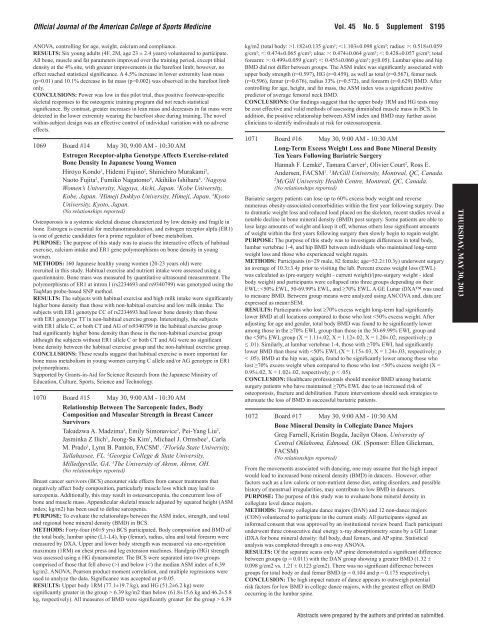Thursday-Abstracts
Thursday-Abstracts
Thursday-Abstracts
Create successful ePaper yourself
Turn your PDF publications into a flip-book with our unique Google optimized e-Paper software.
Official Journal of the American College of Sports Medicine<br />
ANOVA, controlling for age, weight, calcium and compliance.<br />
rEsuLTs: Six young adults (4F, 2M, age 23 ± 2.4 years) volunteered to participate.<br />
All bone, muscle and fat parameters improved over the training period, except tibial<br />
density at the 4% site, with greater improvements in the barefoot limb; however, no<br />
effect reached statistical significance. A 4.5% increase in lower extremity lean mass<br />
(p=0.01) and 10.1% decrease in fat mass (p=0.002) was observed in the barefoot limb<br />
only.<br />
CONCLusIONs: Power was low in this pilot trial, thus positive footwear-specific<br />
skeletal responses to the osteogenic training program did not reach statistical<br />
significance. By contrast, greater increases in lean mass and decreases in fat mass were<br />
detected in the lower extremity wearing the barefoot shoe during training. The novel<br />
within-subject design was an effective control of individual variation with no adverse<br />
effects.<br />
1069 Board #14 May 30, 9:00 AM - 10:30 AM<br />
Estrogen receptor-alpha Genotype affects Exercise-related<br />
Bone density In Japanese young Women<br />
Hiroyo Kondo 1 , Hidemi Fujino 2 , Shinichiro Murakami 3 ,<br />
Naoto Fujita 2 , Fumiko Nagatomo 4 , Akihiko Ishihara 4 . 1 Nagoya<br />
Women’s University, Nagoya, Aichi, Japan. 2 Kobe University,<br />
Kobe, Japan. 3 Himeji Dokkyo University, Himeji, Japan. 4 Kyoto<br />
University, Kyoto, Japan.<br />
(No relationships reported)<br />
Osteoporosis is a systemic skeletal disease characterized by low density and fragile in<br />
bone. Estrogen is essential for mechanotransduction, and estrogen receptor alpfa (ER1)<br />
is one of genetic candidates for a prime regulator of bone metabolism.<br />
PurPOsE: The purpose of this study was to assess the interactive effects of habitual<br />
exercise, calcium intake and ER1 gene polymorphisms on bone density in young<br />
women.<br />
METhOds: 160 Japanese healthy young women (20-23 years old) were<br />
recruited in this study. Habitual exercise and nutrient intake were assessed using a<br />
questionnaire. Bone mass was measured by quantitative ultrasound measurement. The<br />
polymorphisms of ER1 at intron I (rs2234693 and rs9340799) was genotyped using the<br />
TaqMan probe-based SNP method.<br />
rEsuLTs: The subjects with habitual exercise and high milk intake were significantly<br />
higher bone density than those with non-habitual exercise and low milk intake. The<br />
subjects with ER1 genotype CC of rs2234693 had lower bone density than those<br />
with ER1 genotype TT in non-habitual exercise group. Interestingly, the subjects<br />
with ER1 allele C, or both CT and AG of rs9340799 in the habitual exercise group<br />
had significantly higher bone density than those in the non-habitual exercise group<br />
although the subjects without ER1 allele C or both CT and AG were no significant<br />
bone density between the habitual exercise group and the non-habitual exercise group.<br />
CONCLusIONs: These results suggest that habitual exercise is more important for<br />
bone mass metabolism in young women carrying C allele and/or AG genotype in ER1<br />
polymorphisms.<br />
Supported by Grants-in-Aid for Science Research from the Japanese Ministry of<br />
Education, Culture, Sports, Science and Technology.<br />
1070 Board #15 May 30, 9:00 AM - 10:30 AM<br />
relationship Between The sarcopenic Index, Body<br />
Composition and Muscular strength in Breast Cancer<br />
survivors<br />
Takudzwa A. Madzima1 , Emily Simonavice2 , Pei-Yang Liu3 ,<br />
Jasminka Z Ilich1 , Jeong-Su Kim1 , Michael J. Ormsbee1 , Carla<br />
M. Prado1 , Lynn B. Panton, FACSM1 . 1Florida State University,<br />
Tallahassee, FL. 2Georgia College & State University,<br />
Milledgeville, GA. 3The University of Akron, Akron, OH.<br />
(No relationships reported)<br />
Breast cancer survivors (BCS) encounter side effects from cancer treatments that<br />
negatively affect body composition, particularly muscle loss which may lead to<br />
sarcopenia. Additionally, this may result in osteosarcopenia, the concurrent loss of<br />
bone and muscle mass. Appendicular skeletal muscle adjusted by squared height (ASM<br />
index; kg/m2) has been used to define sarcopenia.<br />
PurPOsE: To evaluate the relationships between the ASM index, strength, and total<br />
and regional bone mineral density (BMD) in BCS.<br />
METhOds: Forty-four (60±9 yrs) BCS participated. Body composition and BMD of<br />
the total body, lumbar spine (L1-L4), hip (femur), radius, ulna and total forearm were<br />
measured by DXA. Upper and lower body strength was measured via one-repetition<br />
maximum (1RM) on chest press and leg extension machines. Handgrip (HG) strength<br />
was assessed using a HG dynamometer. The BCS were separated into two groups<br />
comprised of those that fell above (>) and below ( 6.39<br />
Vol. 45 No. 5 Supplement S195<br />
kg/m2 (total body: >1.182±0.135 g/cm²; : 0.518±0.059<br />
g/cm²; : 0.474±0.064 g/cm²; : 0.499±0.059 g/cm²;


